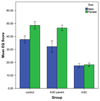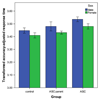Empathy and emotion recognition in people with autism, first-degree relatives, and controls
- PMID: 23174401
- PMCID: PMC6345368
- DOI: 10.1016/j.neuropsychologia.2012.11.013
Empathy and emotion recognition in people with autism, first-degree relatives, and controls
Abstract
Empathy is the lens through which we view others' emotion expressions, and respond to them. In this study, empathy and facial emotion recognition were investigated in adults with autism spectrum conditions (ASC; N=314), parents of a child with ASC (N=297) and IQ-matched controls (N=184). Participants completed a self-report measure of empathy (the Empathy Quotient [EQ]) and a modified version of the Karolinska Directed Emotional Faces Task (KDEF) using an online test interface. Results showed that mean scores on the EQ were significantly lower in fathers (p<0.05) but not mothers (p>0.05) of children with ASC compared to controls, whilst both males and females with ASC obtained significantly lower EQ scores (p<0.001) than controls. On the KDEF, statistical analyses revealed poorer overall performance by adults with ASC (p<0.001) compared to the control group. When the 6 distinct basic emotions were analysed separately, the ASC group showed impaired performance across five out of six expressions (happy, sad, angry, afraid and disgusted). Parents of a child with ASC were not significantly worse than controls at recognising any of the basic emotions, after controlling for age and non-verbal IQ (all p>0.05). Finally, results indicated significant differences between males and females with ASC for emotion recognition performance (p<0.05) but not for self-reported empathy (p>0.05). These findings suggest that self-reported empathy deficits in fathers of autistic probands are part of the 'broader autism phenotype'. This study also reports new findings of sex differences amongst people with ASC in emotion recognition, as well as replicating previous work demonstrating empathy difficulties in adults with ASC. The use of empathy measures as quantitative endophenotypes for ASC is discussed.
Copyright © 2012 Elsevier Ltd. All rights reserved.
Figures




References
-
- Adolphs R, Sears L, Piven J. Abnormal processing of social information from faces in autism. Journal of Cognitive Neuroscience. 2001;13(2):232–240. - PubMed
-
- Allison C, Baron-Cohen S, Wheelwright SJ, Stone MH, Muncer SJ. Psychometric analysis of the empathy quotient (EQ) Personality and Individual Differences. 2011;51:829–835.
-
- Amercian Psychiatric Association. Diagnostic and statistical manual of mental disorders 4th Edn.—Text revision (DSM-IV-TR) Washington, DC: American Psychiatric Association; 2000.
-
- Ashwin C, Chapman E, Colle L, Baron-Cohen S. Impaired recognition of negative basic emotions in autism: A test of the amygdala theory. Social Neuroscience. 2006;1(3–4):349–363. - PubMed
Publication types
MeSH terms
Grants and funding
LinkOut - more resources
Full Text Sources
Other Literature Sources
Medical
Miscellaneous

